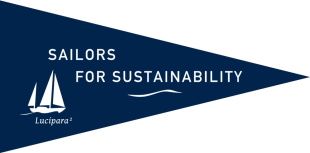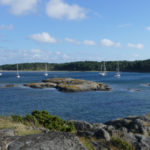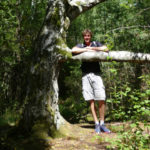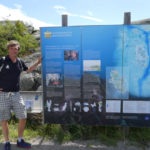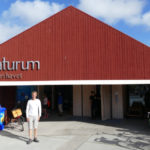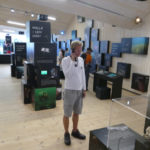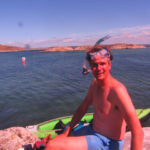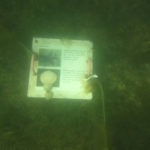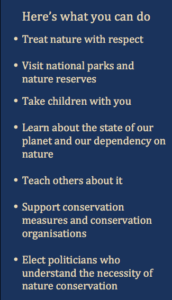Nature Conservation through Access and Education (SWE)
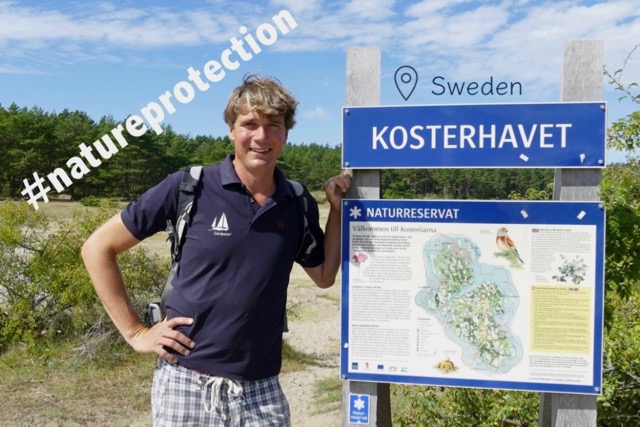
How Swedish education and legal rights to access nature (allemansrätten) lead to its protection.
Contributes to achieving the following UN Sustainable Development Goals:
Sweden’s natural beauty is overwhelming. Some 30 hours after leaving Copenhagen we reach the first of the many Swedish islands that dot the West Coast between Gothenburg and the Norwegian border. They range from tiny rocks to large landmasses of hundreds of km2. Some are bare and inhospitable, others lush with forests and fields. Whether they are uninhabited, populated or private property, they have one thing in common: everyone is allowed to visit them.
In good Scandinavian tradition Sweden recognises and protects the freedom to roam. In Swedish it is called “allemansrätten”, literally “everyman’s right”. It guarantees that everyone can enjoy nature, provided no damage is caused and the owner is not disturbed. It does not apply to cultivated land, so allemansrätten is not a license to pick someone’s apples or camp in their garden. In other words the right is to be exercised with respect for nature and others.
Nature as Common Good
By recognising the people’s right to enjoy nature, Sweden puts public interest first: nature is for everyone and takes precedence over private property. Allemansrätten is so important that it is even enshrined in the constitution. Nature is a common good, is the message.
With this in mind it is no surprise that Sweden was the first European country to create national parks in 1909. These areas of natural beauty enjoy the highest degree of protection. In addition, Sweden has about 4,000 nature reserves, each with its own protection objectives and restrictions. As a result nearly 12 percent of Sweden’s surface area is protected. The goal: to preserve nature for future generations and make nature accessible to visitors.
Research in Kosterhavet
A few years ago Sweden created its 29th national park: Kosterhavet. It is the only marine national park and protects a large area of sea between around the Koster islands, just south of the Norwegian border. It neighbours Ytre Hvaler National Park in Norway to form a large safe haven for coral reefs, fish, mammals and birds.
On our way there we spot porpoises, seals and several species of birds, which indicate that this is a very species-rich area. Not long after dropping our anchor at South Koster’s beach we paddle to the shore and tour the island on foot. We soon encounter signs explaining that a portion of the island is part of Kosterhavet national park. Other sections are designated nature reserves. The sign also features images of plants and animals that can be found in the area. The hiking paths are well marked and quite popular, as we notice on our stroll around the island. The absence of fencing makes us feel welcome. People do live in nature reserves, and in conformity with the “allemansrätten” we don’t trespass on land they have cultivated.
Understanding as the Key to Protecting
Our visit continues at the “Naturum” visitor centre. Audio guides and films provide extensive information about the unique marine life between the mainland and the Koster Islands. We learn that cold, salty water from the Atlantic Ocean flows to Sweden through a trough of up to 250 meters deep. Closer to the surface warmer and less salty water flows from the Baltic Sea. This makes the region particularly rich in flora and fauna. Images of fantastic deep-water creatures and colourful coral reef give a glimpse of the magnificent underwater life. In addition to welcoming visitors to the park, the focus of the visitor centre is clearly to educate visitors on the uniqueness, richness and vulnerability of our oceans.
Our lesson in nature continues outside. The national park has set up a snorkel trail at a popular beach nearby. We can’t wait to go on exploration. Equipped with masks, flippers, snorkels and an underwater camera we dive into the water and swim to the starting point, marked by a red buoy. From there we can follow a rope to underwater stations. Three metres under the surface these underwater stations explain what we can see underwater, such as different types of fish, plants and crab. Thanks to the drawings and with some imagination we make sense of the Swedish texts. In a playful way we learn something about the diversity of the water that surrounds us.
The Science behind it
Swedish botanist Carl Linnæus is known for establishing the modern system of classification of animals and plants in the 18th century. This system (taxonomy) shows the close relationship between animals, plants and their environment, meaning that if one animal or plant is affected, others will also be affected. The understanding of this interdependency is the basis for ecology. In essence it teaches us that if we damage nature, we hurt ourselves. This insight explains the importance of protecting our nature.
Our expedition to Kosterhavet had a similar effect on us. Thanks to the information at the visitor centre we are acutely aware of the unique and rich world beneath our keel, and the importance of preserving it. In a time where more species than ever before face extinction, this is particularly imperative. Only when we appreciate this urgency, fitting measures can be taken. Education and access to protected areas is therefore key to making everyone aware of the value of nature and necessity of preserving it. If we don’t understand nature, we don’t respect it and can’t live in harmony with it.
Sweden Continues to Set the Trend
When Sweden decided to establish national parks a hundred years ago they set a European standard. “Why start modest?” they must have thought, because they created nine parks at once. A bold step, but one that inspired other European countries to follow suit.
This year, Sweden is leading the way again. The government recently declared that its ambition to be the first fossil-free welfare country in the world. By 2050 it aims to be independent of oil and gas, and only rely on clean, renewable energy. There will be no cars that run on petrol, diesel or gas, and buildings will be heated with electricity and heat from the sun. By showing vision and ambition, Sweden sends a strong signal to the rest of the world: this is the path we all should go, and we are going that path.
Related Sustainable Solutions

Restoring Mangroves (VCT)
On Union Island, mangrove restoration has led to increased biodiversity, better coastal protection, and more economic activity.

Wildlife Rescue (SUR)
In Suriname, we meet an organization that rescues wildlife. How does that also help our own survival?

Sea Forests (NAM)
In South Africa and Namibia, we learn about the importance of current and future sea forests. How can they help humanity become more sustainable?

Coral Gardening (PYF)
In French Polynesia we see the beauty of coral reefs, but these important ecosystems are under threat. Fortunately, it’s not too late to save them.

Shark Protection (PYF)
French Polynesia is saving sharks with the largest shark sanctuary in the world. These top predators are vital in keeping reefs and oceans healthy.

A Farm That Restores Nature (CHL)
The Chilean farm Alihuen combines organic farming and tourist education to restore local flora and fauna on former grasslands.

Cleverly Fighting Plastic Pollution (CHL)
Chilean company Algramo uses clever, reusable packaging to reduce plastic waste and save customers money.

Investing in Nature (CHL)
Chilean Patagonia thanks its pristine wilderness to successful conservation efforts. Among them Tompkins Conservation, a remarkable, private initiative.

Artificial Reefs (CPV)
In Cape Verde and Brazil we learn how man-made structures can help to restore underwater ecosystems.

Saving Sea Turtles (CPV)
On the Cape Verdian island of Sal, we meet an organisation that saves sea turtles. We learn how biodiversity can be increased and damaged ecosystems restored while working together with the tourism industry.

Rewilding (GRC)
On the Greek island of Kalamos, we learn about rewilding. We are inspired by the way this form of ecosystem regeneration balances natural and human needs.

Reforestation on Steroids (ITA)
Reforestation helps to fight climate change, drought and fires. Innovations like the COCOON support young trees and accelerate the creation of new forests.

Creative with Cork (PRT)
In Portugal we learn all about the environmental and social sustainability aspects of cork. Time to get more creative with this remarkable natural material!
